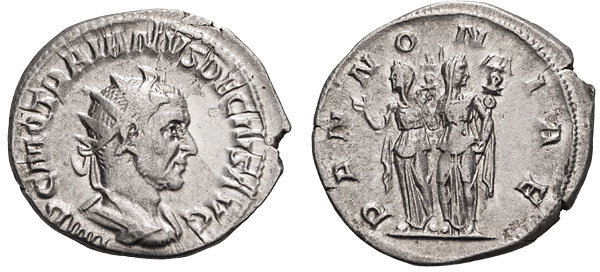Trajan Decius RIC 24
Reproduced from the Gemini Auction 11 catalog courtesy of Curtis Clay (author) and Harlan J. Berk Ltd.

Decius' first PANNONIAE type, RIC 5 and 20, showed only a single Pannonia, draped and veiled, standing left but looking right, half raising her right arm and holding a standard in her lowered left hand, exactly like the Pannonia on the right in our two-figured type and also in the types of the rare RIC 25 and the common RIC 21a. RIC 24 and 25 may be regarded as preliminary artistic attempts to add a second Pannonia to the original single-figured type, before the normal type with two Pannonias, RIC 21a, was reached. In the first attempt, shown by our coin, the Pannonia in the single-figured type was simply duplicated, the only changes being that the second figure was made to look left not right, and that she was placed so close to the first Pannonia that her left arm and the lower half of her standard disappeared behind the raised right forearm of the first Pannonia, and only the top of her standard could be shown between the heads of the two figures. Being close together and near the center of the die, both figures could be made tall, like the single Pannonia in the first type. In the second attempt, RIC 25, all the details of the first attempt were repeated, except that the two Pannonias were made to stand farther from each other, necessitating a reduction in their height since they were now nearer the edges of the die, so that there would be no overlap between them and the left arm and full standard of the second figure could be depicted. This second variant of the two-figured type, like the first, was represented by only a single coin in the Dorchester hoard, but it appears to be a little commoner than the first variety, since four other specimens, all from different obverse and reverse dies than each other, may be seen in Sternberg XVIII, 1986, lot 591; Sternberg XIX, 1987, lot 921; Lanz 102, 2001, lot 918; and on the Four Bad Years website. Finally the decision was made to remove the standard from the left arm of the Pannonia on the left and instead place it upright on the ground before her, behind her half-raised right arm, where it may have been thought to mirror the standard held near the right edge of the type by the first Pannonia, and so to give the type better balance. This is the normal two-figured PANNONIAE type, RIC 21b (slightly misdescribed), represented by 159 antoniniani in the Dorchester hoard, and quite common also on Decius' sestertii, RIC 124a. For the sake of completeness it may be mentioned that this common PANNONIAE type of RIC 21 was replaced towards the end of Decius' reign by yet a third major type bearing the same legend, which showed the two Pannonias standing face to face and clasping right hands in front of a single standard resting on the ground between them (RIC 26 and 41) (Curtis Clay)
New information about the original Dorchester Hoard coin
In 2004, my friend HG in Germany, a long-time collector and expert of Decius'
coins, asked the British Museum for photos of RIC 24 from the Dorcester Hoard.
They sent wrong photos of another coin, RIC 25. When this was brought to
the attention of the
Dept. of Coins and Medals, he received the answer: ... "there does seem to be an
error in the description of coin 24 as listed in RIC and the Num. Chronicle
article." ... "we cannot find a coin in our trays which exactly matches the RIC
24 description." .."the coin from the Dorchester hoard was rather worn" ...
"Looking at it, it appears that the figure on the right has a standard to the
far right of the coin (as you look at it). The figure on the left has no
standard on the far left of the coin and the 2 figures are close together. There
does seem to be a worn standard (hard to see) between the two figures however. I
do think that the condition of this coin is perhaps what may have caused the
confusion."
My friend suggested that the coin pictured back could be described as RIC 25 "only the two Pannoniae stand closer together than they usually do". I have run into this quite a bit - the need to determine what is a different coin type and what is a minor variation between dies (which of course are all somewhat different). Everyone can decide that for themselves but I am sure that the coin pictured above is of the type (and almost certainly same dies) as what Mattingly saw when he documented RIC 24.
Do you know of a similar coin have
something to add to this topic. Of course I'd love to hear it!
marius1@sonic.net